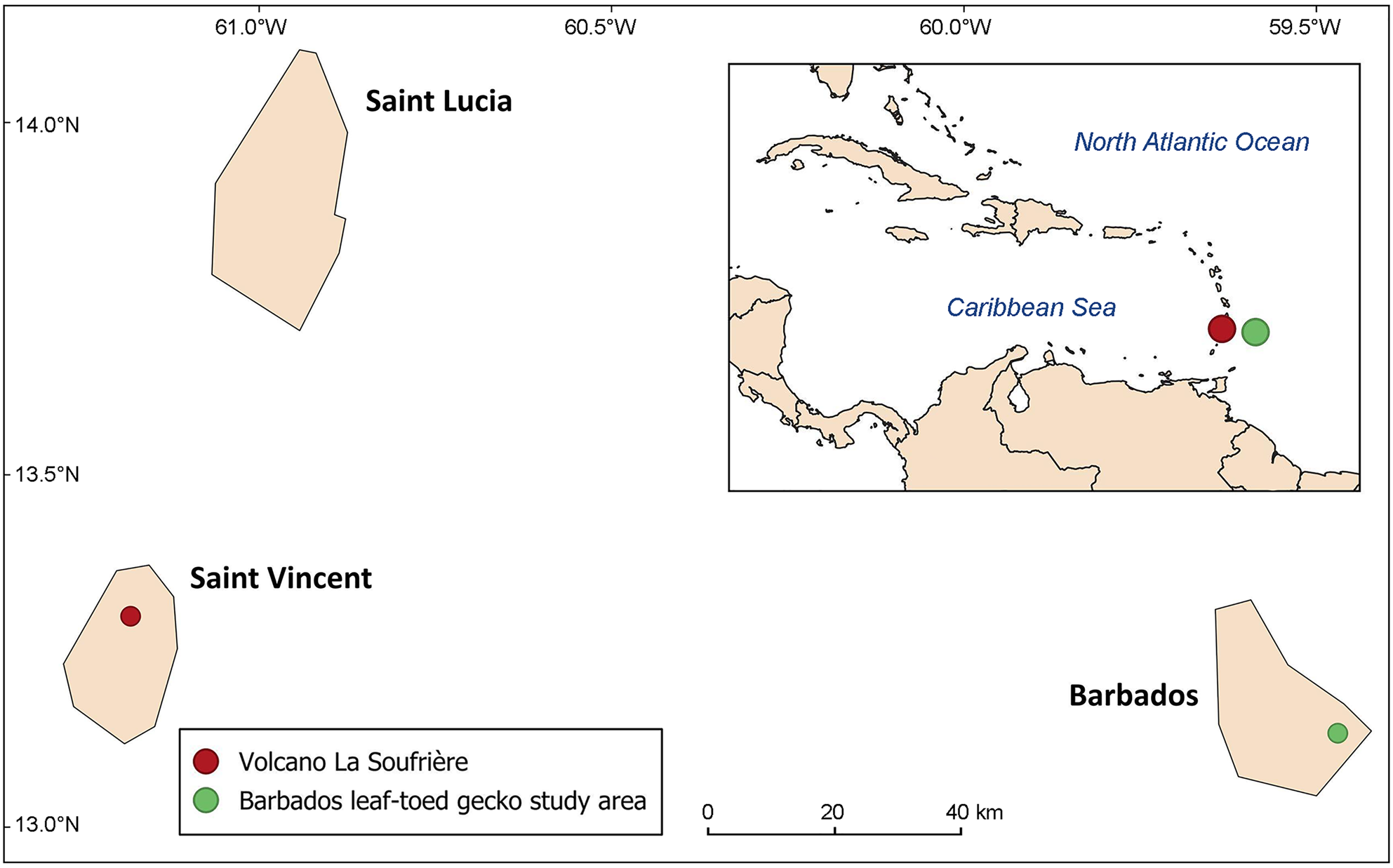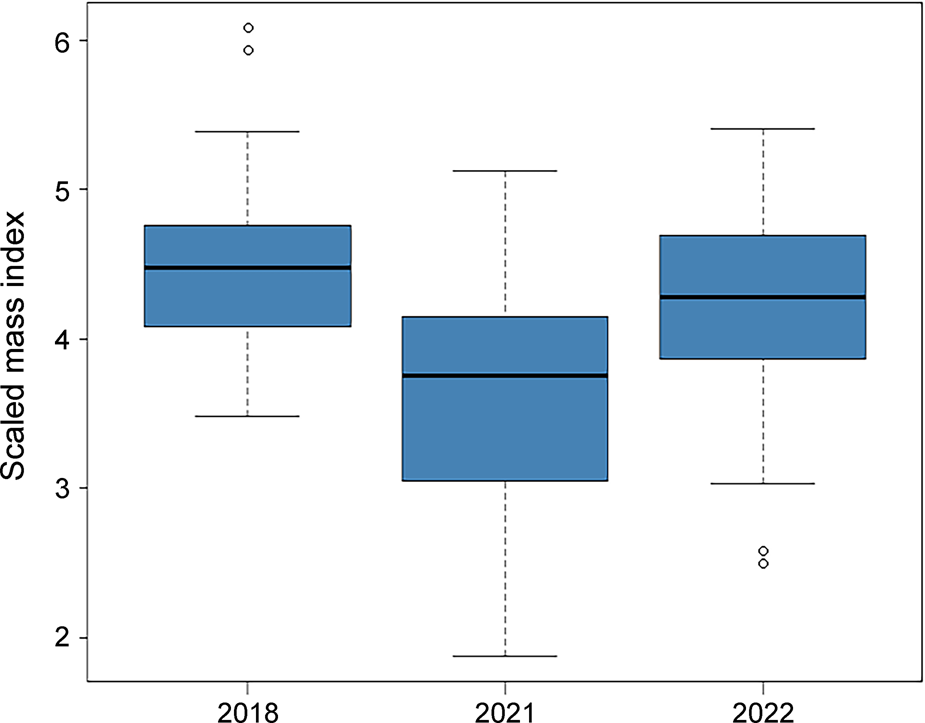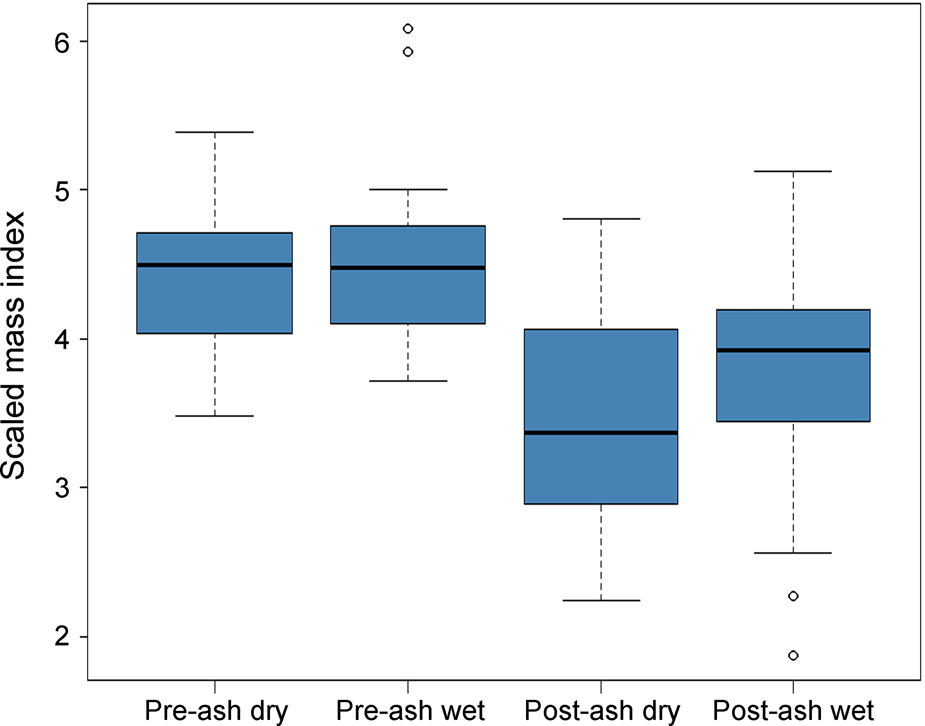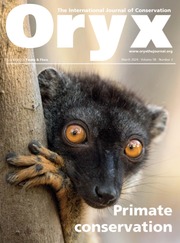Anthropogenic ecosystem disturbance is known to cause declines in the body condition of herpetofauna (Macdonald et al., Reference Macdonald, Driscoll, Macdonald, Hradsky and Doherty2023). These declines can provide an early warning of reduced fitness and subsequent population declines. Natural disturbances, such as hurricanes, are also known to have negative impacts on herpetofauna (Schriever et al., Reference Schriever, Ramspott, Crother, Fontenot and r2009), with small populations being particularly sensitive to such stochastic events (van den Burg et al., Reference van den Burg, Madden, van Wagensveld and Boman2021). This is particularly relevant in the Caribbean, where island endemism is high and many species are range-restricted because of habitat loss (Myers et al., Reference Myers, Mittermeier, Mittermeier, da Fonseca and Kent2000). Volcanoes could pose a significant threat to local species already impacted by anthropogenic effects. Over half of the remnant habitat of the Montserrat oriole Icterus oberi was destroyed following the eruption of the Soufrière Hills volcano in 1995, and this species was subsequently categorized as Critically Endangered in 2000 (Hilton et al., Reference Hilton, Atkinson, Gray, Arendt and Gibbons2003), before being recategorized as Vulnerable in 2016 (BirdLife International, 2023). There are few studies on the impacts of volcanic ash fallout on the health and survivorship of reptile species other than for those of the family Liolaemidae. In the lizard Phymaturus spectabilis, juveniles and gravid females at advanced stages of gestation suffered a reduction in body condition after ash fallout following the eruption of Puyehue volcano in Chile (Boretto et al., Reference Boretto, Cabezas, Kubisch, Sinervo and Ibarguengoytía2014). Female P. spectabilis skipped reproduction during the year of the eruption but had more offspring in the following reproductive cycle. Indices of body condition of offspring born after ashfall were significantly lower than before the eruption. Body condition improved in the second year following ash fallout. The congeners Phymaturus excelsus and Phymaturus sinervoi both showed improved body condition 18 months after ashfall from Puyehue, potentially because of competitive release caused by mortality of herbivorous competitors such as hares and sheep (Ibargüengoytía et al., Reference Ibargüengoytía, Cabezas-Cartes, Boretto, Piantoni, Kubisch and Fernández2016). This was despite negative impacts on the locomotion of P. excelsus and the consequent potential impacts on feeding, reproduction, dispersal and predator avoidance. We have found no literature on the impacts of volcanic ash on the family Gekkonidae.
There are 21 live volcanoes in the Lesser Antilles, and volcanic eruptions are one of the main hazards that threaten the eastern Caribbean region (Lindsay et al., Reference Lindsay, Robertson, Shepherd and Ali2005). Despite the relatively recent eruptions of some of the most active volcanoes, such as Soufrière Hills in Montserrat in 1995 and La Soufrière in Saint Vincent in 1979, there is little information regarding the effects of eruptions on wildlife in the region. La Soufrière, an active stratovolcano on Saint Vincent, had an increase in seismic activity in December 2020. Growth in the effusive dome and sulphur dioxide emissions continued until an explosive eruption occurred on 9 April 2021. A plume of ash was ejected c. 8,000 m into the air and drifted eastwards towards the neighbouring island of Barbados, where significant ashfall was recorded. No estimate of the quantity of ash that fell has been established; however, it resulted in estimated losses and damages costing the island BBD 87 million (Government of Barbados, 2021).
The Barbados leaf-toed gecko Phyllodactylus pulcher, once presumed extinct but rediscovered in 2011, is endemic to the island of Barbados and is the only known leaf-toed gecko in the Lesser Antilles. It is a small (up to 65 mm snout–vent length), nocturnal, insectivorous, saxicolous species and is one of the last extant endemic vertebrate species in Barbados. Clutch size is 1–2 eggs. Surveys in 2013 and 2014 indicated an estimated population of c. 12,000 individuals in a total area of 0.31 km2 (Williams et al., Reference Williams, Horrocks and Pernetta2015). Because of the small size of its documented range, the species is categorized as Critically Endangered on the IUCN Red List (Daltry, Reference Daltry2016). Later surveys by Blades (Reference Blades2019) reported a smaller range (0.18 km2) and a smaller population size (6,000). This reduction in estimated population size was believed to be a more accurate estimate rather than being reflective of a population decline. The population is highly fragmented and only known from a narrow strip of unprotected coastal limestone cliff on the south-eastern and northern coasts of the island. The species does not have any specific protection under Barbados law, except from export under the Third Schedule of the International Trade in Endangered Species of Wild Fauna and Flora Act (2006). Because of the current impacts of anthropogenic effects, invasive alien species, lack of protection and small population size and range, the Barbados leaf-toed gecko is susceptible to stochastic events, particularly events with wide areas of impact such as volcanic eruptions.
We assumed that toxic volcanic ash from La Soufrière would have direct impacts on geckos as well as secondary impacts on prey availability, resulting in a quantifiable decline in mean body condition. We conducted surveys to assess the body and reproductive condition of the species after this event and in the following months to test this assumption and to monitor long-term morphometric impacts.
We conducted surveys in Barbados during May 2021–August 2022, after the eruption of La Soufrière in April 2021 (Fig. 1). We traversed sites along the coastline within the known range of the Barbados leaf-toed gecko on foot during 19.00–22.00 using white lights, searching the complex three-dimensional habitat on limestone surfaces, under vegetation and loose rocks and in crevices, being careful not to damage the species’ habitat. We recorded the location of each leaf-toed gecko sighted, using a GPS. Where possible, we captured the geckos, weighed them with a spring scale (Pesola, Switzerland), measured snout–vent length using a digital Vernier calliper accurate to 0.01 mm, sexed them and assessed their reproductive condition and any signs of tail autotomy. We took photographs of the dorsal patterns, to identify recaptures. We then released geckos at their point of capture and continued with the survey. We identified individuals with assistance from the Interactive Individual Identification System, an open-access pattern recognition software (Hartog & Reijns, Reference Hartog and Reijns2014).

Fig. 1 The Caribbean islands of Saint Lucia, Saint Vincent and Barbados, showing the location of the volcano La Soufrière and the study area where we surveyed the Barbados leaf-toed gecko Phyllodactylus pulcher.
We used the data collected during the post-eruption surveys to assess changes in reproductive condition, tail autotomy and body condition of adults. We determined adult geckos to be individuals > 43 mm in snout–vent length based on the smallest gravid female captured. We compared these data to those collected from 67 geckos in 2018, representing a baseline prior to volcanic ash fallout. We calculated the scaled mass index of each individual as an index of body condition (Peig & Green, Reference Peig and Green2009) and used an analysis of covariance (ANCOVA) to examine any differences between pre-ashfall indices in 2018 and post-ashfall indices in 2021. Covariates were sex, signs of tail autotomy, season and number of eggs. Two seasons are recognized in the Caribbean region: the dry season during January–June and the wet season during July–December. We conducted the ANCOVA in R 4.2.2 (R Core Team, 2021).
We collected 89 snout–vent length and mass measurements during May–December 2021 and a further 93 in 2022. We caught 53 geckos in the wet season and 36 geckos in the dry season in 2021, and 12 geckos in the wet season and 81 geckos in the dry season in 2022. We compared these to data collected from 67 geckos captured and measured in 2018, of which we caught 57 in the wet season and 10 in the dry season. There was a significant difference in body condition between 2018 pre-ashfall and both post-ashfall years (Fig. 2; df = 200, F = 11.82, 2021: P(>|t|) < 0.001; 2022: P(>|t|) = 0.018), as well as between 2021 and 2022 (P(>|t|) < 0.001). There was significant difference in body condition between geckos bearing eggs versus those without eggs (P(> F) = 0.002), but no significant difference was detected between geckos with autotomized versus non-autotomized tails (P(> F) = 0.130). Post hoc analysis revealed significant differences between both the pre-ashfall 2018 wet season and the post-ashfall 2021 wet season (Fig. 3; Tukey test; t = 4.076, P(>|t|) < 0.001) and the pre-ashfall 2018 dry season and the post-ashfall 2021 dry season (t = 3.456, P(>|t|) = 0.004). This trend was present in females (Table 1), although we did not detect a significant difference in body condition in males between the pre-ashfall 2018 and post-ashfall 2021 wet seasons (df = 48, F = 7.831, P(>|t|) < 0.101).

Fig. 2 Box plot showing the median, interquartile range, total range and outliers of the scaled mass index, used as an index of body condition, of Barbados leaf-toed geckos before (2018) and after (2021 and 2022) the volcanic ash fallout event in April 2021.

Fig. 3 Box plot showing the median, interquartile range, total range and outliers of the scaled mass index, used as an index of body condition, of Barbados leaf-toed geckos recorded during the wet and dry seasons before (pre-ash) and after (post-ash) the volcanic ash fallout event in April 2021.
Table 1 Results of the Tukey post hoc tests examining differences in the scaled mass index, used as an index of body condition, between dry and wet seasons, for female (above diagonal) and male (below diagonal) Barbados leaf-toed geckos Phyllodactylus pulcher separately, before (2018) and after (2021) the La Soufrière volcano ashfall event (Fig. 1). Values are estimate ± SE (t, P). Significant differences are highlighted in grey.

The proportion of gravid females decreased significantly immediately after ashfall (28% in 2018, 11% in 2021) but increased significantly in the following year (49% in 2022; df = 2, χ 2 < 0.001). Immediately after ashfall we did not capture any gravid females bearing two eggs. In 2022 we found more than double the proportion of gravid females with two eggs compared to during 2018 (21% in 2018, 46% in 2022), a significant difference (χ 2 < 0.001). During both 2018 and 2021, we detected no significant difference between the wet and dry seasons in the proportion of females that were gravid (df = 2, 2018: χ 2 = 0.65, 2021: χ 2 = 0.78). The rate of tail autotomy was not significantly different between males (pre-ashfall = 84%, post-ashfall = 95%, χ 2 = 0.226) or females (pre-ashfall = 79%, post-ashfall = 74%, χ 2 = 0.643).
Ash persisted in habitat used by P. pulcher for four months following volcanic ash fallout and probably caused negative impacts on the body condition of the Barbados leaf-toed gecko (Plate 1). The ashfall event occurred in Barbados in April, 2 months before the beginning of the wet season. The significant difference in indices for females between the pre-ashfall and post-ashfall wet and dry seasons could suggest that food availability was affected by the ashfall. Arthropods are known to suffer significant declines following ashfall (Marske et al., Reference Marske, Ivie and Hilton2007), and declines in arthropod prey availability in response to volcanic ashfall have been implicated in declines of the Montserrat oriole (Hilton et al., Reference Hilton, Atkinson, Gray, Arendt and Gibbons2003; Marske et al., Reference Marske, Ivie and Hilton2007). The significant effects detected for the covariate egg number is probably related, as eggs are likely to increase individual mass and only females can bear eggs. The reason for an absence of significant differences between pre-ashfall and post-ashfall body condition indices in males during the wet season is unclear. Body condition indices may have increased during the wet season because of a greater availability of arthropod prey. Tanaka and Tanaka (Reference Tanaka and Tanaka1982) reported a doubling in the abundance of arthropods during the wet season in the Caribbean island of Grenada. Perhaps males can better monopolize food resources than females or there is a synergy between the effect of food resources and other factors that we did not measure. The primary cause of body condition decline is not known. Volcanic ash can also have direct impacts on health through, inter alia, fluorosis (Cronin et al., Reference Cronin, Neall, Lecointre, Hedley and Loganathan2003), digestive blockage, eye damage (Flueck, Reference Flueck2016), fibrosis and lung inflammation (Cullen et al., Reference Cullen, Jones, Miller, Tran, Davis and Donaldson2002). The short-term impacts of ash on vegetation dynamics vary, ranging from mortality to increased growth rates (Magnin et al., Reference Magnin, Villalba, Torres, Stecconi, Passo, Sosa and Puntieri2016; but see also Swanson et al., Reference Swanson, Jones, Crisafulli, González and Lara2016). It is probable that the decline in body condition of the Barbados leaf-toed gecko was a result of a synergy between direct impacts on health and secondary effects of cover vegetation mortality and arthropod declines resulting in a reduction in available prey.

Plate 1 Volcanic ash particles in the eye of a Barbados leaf-toed gecko Phyllodactylus pulcher. Photo: Dennis Connor Blades.
The rate of tail autotomy did not change following ashfall, possibly suggesting predator species were not significantly impacted by the event. Alternatively, vegetation mortality may have offset potential negative impacts on predators by providing fewer forage areas with scrub cover for geckos. It is possible that 1 year was insufficient time to detect changes in tail autotomy, as geckos show evidence of tail autotomy throughout their life.
Significantly fewer female P. pulcher were gravid immediately following ash fallout in 2021 but the proportion of gravid females increased significantly in 2022. This increase was coupled with a greater proportion of geckos bearing two eggs rather than one. This provides evidence that the ashfall event had a negative impact on reproduction. These results align with the findings of Boretto et al. (Reference Boretto, Cabezas, Kubisch, Sinervo and Ibarguengoytía2014), who found that P. spectabilis skipped a reproductive cycle after a volcanic eruption and increased reproductive output in the following year. This could suggest P. pulcher is able to forgo reproduction in response to poor conditions, to devote scarce resources towards the growth of fat reserves and therefore improve individual fitness and fecundity in the long term.
Body condition indices of geckos increased towards pre-ashfall levels in the year following the event (Fig. 2). This may reflect a gradual increase in arthropod prey as populations recovered. Additionally, it may suggest that any direct negative impacts of ash on geckos are short term. At least in the short term, P. pulcher and other small lizards appear able to recover quickly following volcanic ashfall. Continued monitoring to determine the population-level response would facilitate detection of any further, longer-term impacts of ashfall on this small island population.
It was not possible to mitigate the effects of ashfall on the Barbados leaf-toed gecko. However, our findings could be used by conservationists and managers to plan accordingly following any volcanic eruption, and suggest the need to secure ex situ populations for species that are Critically Endangered or are threatened by natural events such as volcanic eruptions.
Author contributions
Fieldwork, analysis: DCB; study design, writing: both authors.
Acknowledgements
We thank research assistants Athena El-Badoui, Keimal Davis, Chad Barrow, Rohan Payne and Adrian Bellamy; the Barbados Defence Force for their assistance in accessing specific survey areas; and Julia Horrocks of the University of the West Indies for her guidance. This research was made possible through funding provided by the Conservation Leadership Programme and the Global Environmental Facility under the project Preventing Costs of Invasive Alien Species in Barbados and the OECS Countries, coordinated by the Centre for Biosciences and Agriculture International. Activities were supported and facilitated by Fondation Segré Conservation Fund at Fauna & Flora and by the Biodiversity Conservation and Management Section of the Ministry of Environment and National Beautification, Green and Blue Economy of the Government of Barbados.
Conflicts of interest
None.
Ethical standards
This research abided by the Oryx guidelines on ethical standards. Research included the careful, safe handling of Barbados leaf-toed geckos by experienced personnel, with minimization of any necessary contact. Approval or permits were not required for the research but the Barbados Ministry of Environment and National Beautification, the relevant agency in charge of wildlife protection in Barbados, was consistently informed and updated throughout the study.
Data availability
The data that support the findings of this study are available from the corresponding author, DCB, upon reasonable request. The data are not publicly available because of concerns regarding collection for the wildlife trade.







